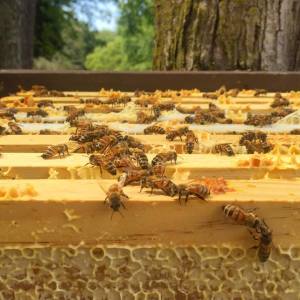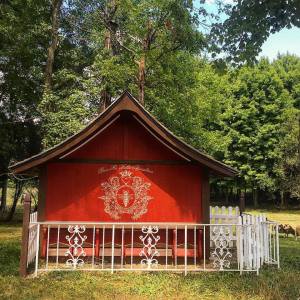Join us in our ongoing commitment to transform our farm into a safe haven for honey bees and other pollinators.
“If the bee disappeared off the face of the earth, man would only have four years left to live.” 
– Maurice Maeterlinck, The Life of the Bee
The honey bees are suffering. All over the world, bees are dying by the millions. They are dying from pesticides. They are dying from herbicides that kill their food supply. They are dying as natural habitats are replaced with land developments. They are dying from mites that attack their young and weaken their colonies. Bees are crucial to our food supply. Bees are crucial to the vast majority of plants that grow on this planet and they are crucial to the animals, like humans, who need these plants to survive. These gentle creatures work tirelessly to pollinate our world and they are even generous enough to provide us with honey so that we might enjoy the sweetness of the Earth.
“Seventy out of the top 100 human food crops — which supply about 90 percent of the world’s nutrition — are pollinated by bees.”
– Greenpeace USA
It was an easy decision for us to turn our 25 acre family farm into a sanctuary for honey bees and native pollinators. We have the land. We are passionate about honeybees. My grandparents and great-grandparents kept bees, so we are maintaining an Old World family tradition during a period of time that is crucial for conserving these insects. Each step of our plan will not only help save the bees, but these steps also fit perfectly with our current farm plan to provide all natural farm products and pollinator education to our local community. Honeybees and horses can graze side by side on lush pasture. Acres of hay and buckwheat feed the bees when it’s out in the field and feed our animals when its harvested. Meadows of wildflowers feed the bees and later provide herbal plant medicine in farm-made soaps and other products. Groves of berries will be pollinator forage, offer wildlife refuge, and the fruit can be offered to our customers to enjoy at the end of the season. Everything we do is all natural and free of chemicals. All of our ideas have sustainability in mind.
The plan is simple. We have signed up to work with the USDA Natural Resources Conservation Service to explore sustainable methods of maximizing our land to provide as much safety and forage as possible for pollinators.
- Pastures for grazing: We plan to increase the amount of bee forage in the land that we use for grazing our livestock. Our pastures are already rich in clover and we plan to add more. By practicing pasture rotation, we can assure that the vegetation isn’t grazed below 4 inches high. This allows the plants to bloom for our bees before being grazed by horses, sheep, and poultry. As the animals graze they naturally fertilize the land with what they leave behind. This arrangement not only helps the bees but also provides quality food for our animals.
- Hay Fields and Buckwheat: We currently grow hay on five acres of our farm and buckwheat on one acre. The hay is filled with clover and other plants that our bees currently enjoy and the blooms are generally spent before the hay is harvested. After the hay is harvested the plants grow back again and provide fresh pollinator forage. The buckwheat was planted specifically with our bees in mind. Buckwheat is fast-growing and can have up three blooms per year. That’s millions of flowers for the bees and other insects. The buckwheat itself is harvested to feed our livestock and the plants regrow quickly.
- Wildflower Meadows: By carefully selecting flowering plants and managing meadows that are specifically aimed at creating optimal honey bee and pollinator forage, we will provide a natural refuge for honey bees, pollinators, and other wildlife. With plants that are designed to provide a succession of flowers all year long, bees will have a steady and safe source of food. Thanks to research done by the USDA, we can work with conservation experts to create fields of flowers that will be fully established within three years. The plants that we choose will have further value as herbal medicine. After the bees have enjoyed the plants, the dried flowers and herbs can be offered for sale at our farmstand for apothecary use and added to farm-made soaps, salves, teas, and other products.
- Maintaining Maple Forest: We currently have about one acre of established maple trees. Maple trees are one of the first foods for honey bees in the early Spring. The sap and the blooms on maple trees provide a much needed boost after the winter. We plan to preserve these maple trees, and we are also in the process of fencing the woods to allow our heritage pigs to forage in the undergrowth. With careful management, the pigs can help keep the forest floor clear and healthy.
- Berry Grove: For years we have been discussing the development of an area for berries on our farm and we have now chosen the location. We plan to add about 1/2 acre of berries. The USDA has a list of recommended berries that are ideal for bees including: blackberries, raspberries, serviceberries, elderberries, gooseberries, and more. These traditional heritage berries are a perfect match for our farm because we aim to provide traditional Old World food. Berries can be offered for sale at our farmstand and can be used to make a variety of value-added products such as jelly, jam, and baked goods.
- Expanded Apiaries: Our first goal for increasing our apiaries is to increase our number of beehives from four to eighteen. Our honey bees currently live in an Eastern European influenced honey bee house. We use standard Langstroth bee hives that are sheltered inside the bee house with entrances so that the bees can come and go as they please. The house is working out very well for us. It provides protection from the elements, particularly in the winter when bees are susceptible to cold temperatures. The added protection of the house means that bees don’t have to work as hard to stay warm to survive the winter. Because the hives are protected, we don’t need to replace equipment as often as you would for hives that are outdoors. The wooden components are shielded from moisture and don’t rot. Our current bee house has a capacity to hold six hives. As we add more bees, we would like to place two additional bee houses in other locations on the farm for a total of eighteen colonies. We believe that we will have enough demand for our honey after we expand as we already have much higher demand than we have supply. We currently provide honey to a very devoted customer base as well as some local organizations. By expanding our apiaries we can offer an increased range of honey products such as cut comb honey, creamed honey, beeswax, and pollen. By expanding, we can also grow our wholesale market and sell honey to stores, restaurants, and meaderies. Honey will help fund our operation. In a way, the bees themselves will be helping to sustain their preserve.
- Native Pollinators: Our bee preserve will not only help the honey bees, but will also provide safe habitats for native bees, butterflies, and other crucial beneficial insects. Native pollinators will benefit from the flowers and naturalized spaces, and we plan on adding pollinator hotels in different areas of our farm to create safe places for them to live. Pollinator hotels are built with the nooks and crannies that are found in nature that pollinators like to call home.
- Community Involvement and Education: We plan to offer farm tours to encourage community involvement, to allow transparency so that our customers can be aware of what’s involved with responsibly raising honey bees and see for themselves the work that it takes to raise happy animals. Farm tours will also give us an outlet to spread awareness of the plight and beauty of honey bees because every aspect of the way our farm operates takes bees into consideration. We can provide walking tours, golf cart tours, or hay ride tours for larger groups.
- Bee Barn: Ultimately, we plan on adding a Bee Barn to our farm. The Bee Barn will be key, because it will be the home base of the bee preserve. It will provide additional space for more bee hives and pollinator hotels, and it will include a safe observation area so that visitors can watch and learn more about the fascinating behavior of bees. It will contain a honey bee education center to support community outreach. It will feature a honey room for bottling our honey. Our honey is always responsibly and sustainably harvested with the health and happiness of the bees as our first priority.


